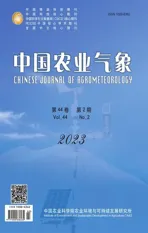日光诱导叶绿素荧光研究及应用的文献计量分析*
2023-02-02闫雨杏吕肖良王亚凯
闫雨杏,吕肖良,王亚凯,于 强**
日光诱导叶绿素荧光研究及应用的文献计量分析*
闫雨杏1,吕肖良2,王亚凯1,于 强2**
(1.西北农林科技大学资源环境学院,杨凌 712100;2.西北农林科技大学黄土高原土壤侵蚀与旱作农业国家重点实验室,杨凌 712100)
日光诱导叶绿素荧光SIF(solar-induced chlorophyll fluorescence)作为直接监测植被光合作用的理想“探针”,能对植物的生理状态作出快速、灵敏的响应,是近年来植被遥感领域的研究热点。为了系统梳理SIF研究的发展脉络,本研究以Scopus数据库中1982-2021年的786篇相关文献作为数据源,结合VOSviewer软件,从国家、机构、作者、期刊和关键词等角度分别进行文献计量分析和可视化计量分析。结果表明,SIF领域年发文量整体呈增长趋势,现已进入快速发展阶段;发文量排名前3的国家分别为美国、中国和德国,其中德国拥有最高的篇均被引次数(56.2次)和最多的合作国家数(36个);南京大学、加州理工学院、瓦伦西亚大学等机构有着较高的发文量和H指数,为该领域的发展做出了突出贡献;Guanter、Zhang、Frankenberg、Liu、Rascher等国内外学者致力于该领域的研究,发表论文数均在40篇以上;期刊Remote Sensing of Environment在该领域中拥有最高发文量(92)和最高的H指数(40),Global Change Biology拥有最高的篇均被引数(65.6次)。关键词反映出这一研究方向属于地球科学、生态学、农学、植物生理学等多学科的交叉领域,涵盖了叶片、冠层乃至区域等空间尺度;当前研究主要集中在叶绿素荧光的生理特性及胁迫监测、SIF信号的获取方式和SIF遥感应用(如碳循环)等三个方面。中国在该领域的整体研究实力走在世界前列,未来仍需进一步提高研究影响力。
日光诱导叶绿素荧光;植被遥感;文献计量分析;VOSviewer
日光诱导叶绿素荧光SIF(solar-induced chlorophyll fluorescence)是指植物叶绿体在太阳光照条件下叶片自身发射出的一种光谱信号(650-850nm)[1],在红光(680nm左右)和近红外(740nm左右)波长处存在两个明显的荧光峰值。叶绿素荧光可以直接反映光合作用光反应中的电子传递速率大小[2],而电子传递速率又受光合作用暗反应中碳同化的影响,因此,叶绿素荧光可以作为无损监测植被光合作用的理想“探针”[3−4]。近年来,研究表明,SIF遥感为大范围监测全球植被光合作用提供了一种全新的测量方式[5−7],其估算能力优于植被“绿度”指数的遥感方法[8−10]。此外,SIF在研究植物的逆境、胁迫、病理等与生态系统变化相关的问题上,也发挥着重要作用[11]。
自1931年Kautsky首次用肉眼观察并记录到叶绿素荧光强度与叶片光合过程有关,叶绿素荧光逐渐成为一种与植物光合作用研究相结合的新技术,可以作为监测植物对环境响应的有效工具[12−13]。随着高光谱传感器的发展和荧光探测项目FLEX(fluorescence explorer)的推进,特别是在2011年日本温室气体卫星GOSAT首先在全球尺度上实现了SIF的遥感反演后,叶绿素荧光遥感和碳循环应用研究得到了迅速发展,多篇里程碑式的研究论文相继发表在PNAS、Science等期刊上[8−9]。随着SIF研究领域文献的日益增多,学者们基于多种角度在该领域进行了探讨分析。Meroni等[14]对SIF遥感原理、反演方法及其应用情况进行了介绍,主要回顾了地基平台SIF的相关反演方法和应用研究。章钊颖等[4]阐述了近年来SIF在陆地生态系统总初级生产力GPP(gross primary productivity)估算、全球碳循环监测、物候和植被胁迫监测等方面的应用现状,并从卫星SIF反演算法优化、SIF-GPP关系机理、SIF多尺度综合观测等方面,展望了植被SIF遥感的发展前景。詹春晖等[15]回顾了叶片、冠层和生态系统尺度的SIF模型,从建模机理出发,对比了不同模型的性能,指出了未来SIF辐射传输模型的前景。孙忠秋等[16]总结了现有全球SIF产品存在的问题和后续SIF卫星探测计划的发展方向,为现有SIF卫星产品的应用以及未来SIF探测卫星载荷方案的设计提供了参考。上述研究综述对SIF领域的研究进展进行了全面总结,但缺少针对SIF领域文献发展特征与热点演变较为清晰直观的整体性概述。
随着SIF领域研究的不断发展与深入,当前迫切需要对该领域整体发展变化特征与研究热点演变进行评述。本研究采用文献计量学方法,通过检索Scopus数据库中SIF研究领域的相关文献,运用可视化分析软件VOSviewer绘制知识图谱,对SIF领域大量已发表文献的数量发展、高产国家、高产机构、高产作者、热点期刊、高频关键词等进行特征分析,系统地对SIF研究进行整理归纳、分析总结和展望,以期更深入了解SIF领域文献的基本发展特征和研究热点演变。
1 资料与方法
1.1 文献检索
研究数据来自提供标准化、高质量学术出版物信息的Scopus数据库(https://www.scopus.com/)。该数据库包含的期刊范围较为广泛,且在支持关键词搜索和引文分析方面更具优势和影响力[17],在众多学科领域中被学者们广泛使用。数据检索日期为2021年7月16日,在Scopus高级检索模块下,选取关键词“日光诱导叶绿素荧光”,通过对文章标题、摘要和关键词的主题域(TS)进行检索:“TS(主题)= TITLE-ABS-KEY (sun AND induced) OR TITLE- ABS-KEY (solar AND induced) OR TITLE-ABS-KEY (SIF) AND (TITLE-ABS-KEY (chlorophyll AND fluorescence) OR TITLE-ABS-KEY (chl AND fluorescence)”,检索到了1982−2021年发表在SIF领域的803篇英文论文,文献类型为期刊论文和会议论文。查阅并剔除重复和不相关的文献后,最终得到用于本研究分析的文献786篇。
1.2 分析方法
文献计量分析是一种利用定量分析和统计学原理来描述某一特定领域文献特征的方法[18]。这种分析通过研究特定领域论文发表的模式和动态,能够有效反映相关研究的热点和未来趋势[19],在科学研究中发挥着重要作用。本研究从国家、机构、作者、关键词等方面对786篇文献进行了分析,将总被引数、篇均被引数、期刊影响因子,以及作者、机构、国家和期刊的H指数作为衡量科学影响力的指标。H指数被用作学术成就的衡量标准之一[20],其定义为一个作者(或机构、国家/地区、期刊)有H篇文献的被引次数至少为H次。因为Scopus数据库没有提供作者的全名信息,为了避免不同作者有着相同的缩写名而对后续分析造成影响,基于研究者信息(如所属单位、学科领域和合著者信息等)手动消除歧义[21]。国家/地区之间的学术合作和关键词的共现情况通过共现图谱呈现。在初次生成共现图谱后核查结果,对图谱网络中相同含义的词汇(包括英文单复数、简称和全称以及同义词等)进行合并,例如solar-induced chlorophyll fluorescence与SIF、gross primary production与GPP、vegetation indices与vegetation index等,并对高频关键词进行分析,得到领域的研究热点。全文出现的“关键词”是指“作者关键词”,即作者自己给出的关键词。
1.3 数据处理
使用R(3.5.1)编程语言(University of Auckland Statistics Department,https://www.r-project.org/)结合Excel对文献数据进行计量分析,用到的R语言程序包主要包括“bibliometrix”和“stringr”[22],并使用VOSviewer[23]软件对作者、机构、国家的合作以及关键词的共现进行可视化。VOSviewer能够清晰解读某一领域的知识结构、发展趋势、研究热点等信息,因其可视化效果好、功能全面、分析结果准确而被广泛应用[24]。
2 结果与分析
2.1 有关日光诱导叶绿素荧光文献的基本特征分析
2.1.1 发文数量
文献数量的年度变化可以整体反映该领域的研究趋势,文献的被引数可一定程度上反映文献的学术影响力。由图1a可见,检索到SIF领域的研究文献从1982年的1篇增至2020年的111篇,整体呈现发文量不断增加的趋势。1982−1993年关于SIF的文献发表数量较少,2002−2011年每年发表的数量则稳定在15篇左右,2015年开始发文快速增加,直到2020年达到高峰,表明对SIF的研究进入了快速发展阶段。被引数在2013年之前整体随时间推移呈波动增长趋势,2013年之后随着SIF的遥感反演在全球尺度上得以实现,里程碑式的优秀文献不断涌现[8−9]且快速增长。2015年发表文献的被引数达到高峰,全年共计被引2610次。由图1b可见,进行(发表)SIF相关研究的作者、机构、期刊和国家数量也从2013年之后开始急剧增加。这些数据表明,关于SIF领域的研究在过去10a里不断增长,学术合作也日益增多和活跃。由于统计时间截至2021年7月,因此2021年的数据不表征全年的数据特征。
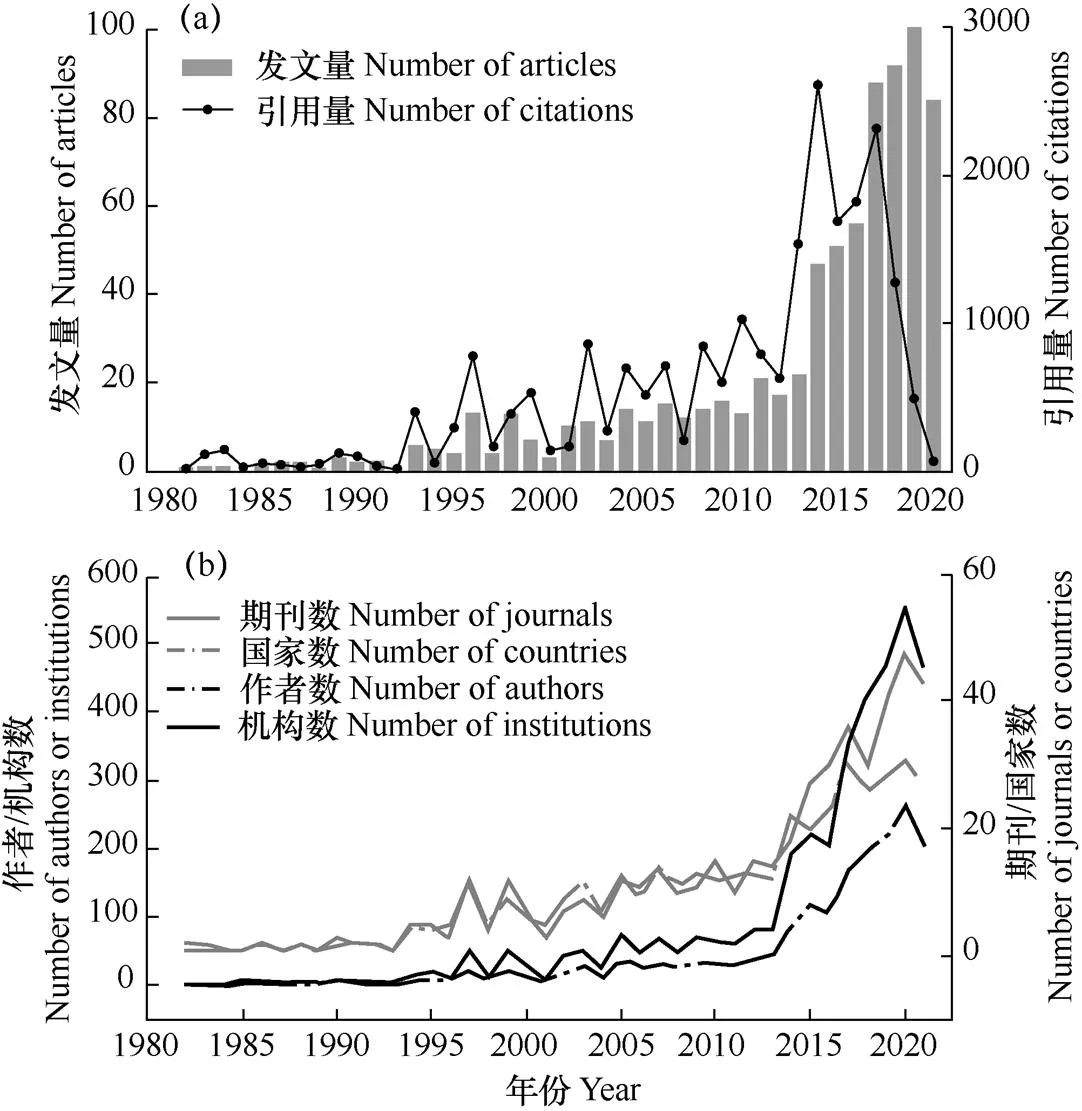
图1 1982−2021年关于日光诱导叶绿素荧光(SIF)研究年发表文献数量/被引数(a)及研究作者/机构/期刊/国家数量(b)
2.1.2 论文引用
表1列出了关于SIF研究的前10篇最高被引论文。其中美国研究者参与了9篇,德国研究者参与了7篇,表明美国和德国的研究者在SIF研究的前沿领域表现活跃。此外,前10篇文章中有3篇发表在Remote Sensing of Environment期刊上,表明该期刊在SIF研究领域具有较高的影响力。在这10篇文章中,有7篇研究SIF反演及其与总初级生产力GPP的关系,2篇分别对SIF的估算方法、应用和光合作用的联系进行了综述,另外1篇是利用SIF数据研究水文气候和热带森林生产力之间的联系。最高被引论文[8]于2014年发表在PNAS[8],被引次数为507,研究发现SIF为农田和草地生态系统的GPP估算提供了一种全新的方法,且估算精度显著高于碳循环模型模拟结果,并表明SIF有助于改进全球模型,以更准确地预测农业生产水平和气候对作物产量的影响。排名第二的论文[25]发表在2011年的Geophysical Research Letters上,被引次数为483,该文章基于日本温室气体卫星GOSAT在全球尺度上首次实现了SIF的遥感反演,为全球GPP的准确估算提供了更加可靠的数据源,有利于约束陆面过程模型中的植被光合过程的模拟,从而提高全球碳循环模拟精度。排名第三的论文[14]发表在2009年的Remote Sensing of Environment上,被引次数为474,通过回顾40多篇关于估算SIF的科学论文,概述了各种方法的理论假设和优缺点,并讨论了测量到的SIF信号在近地面、航空和卫星平台三种观测尺度上的应用,为今后的相关研究提出了展望。
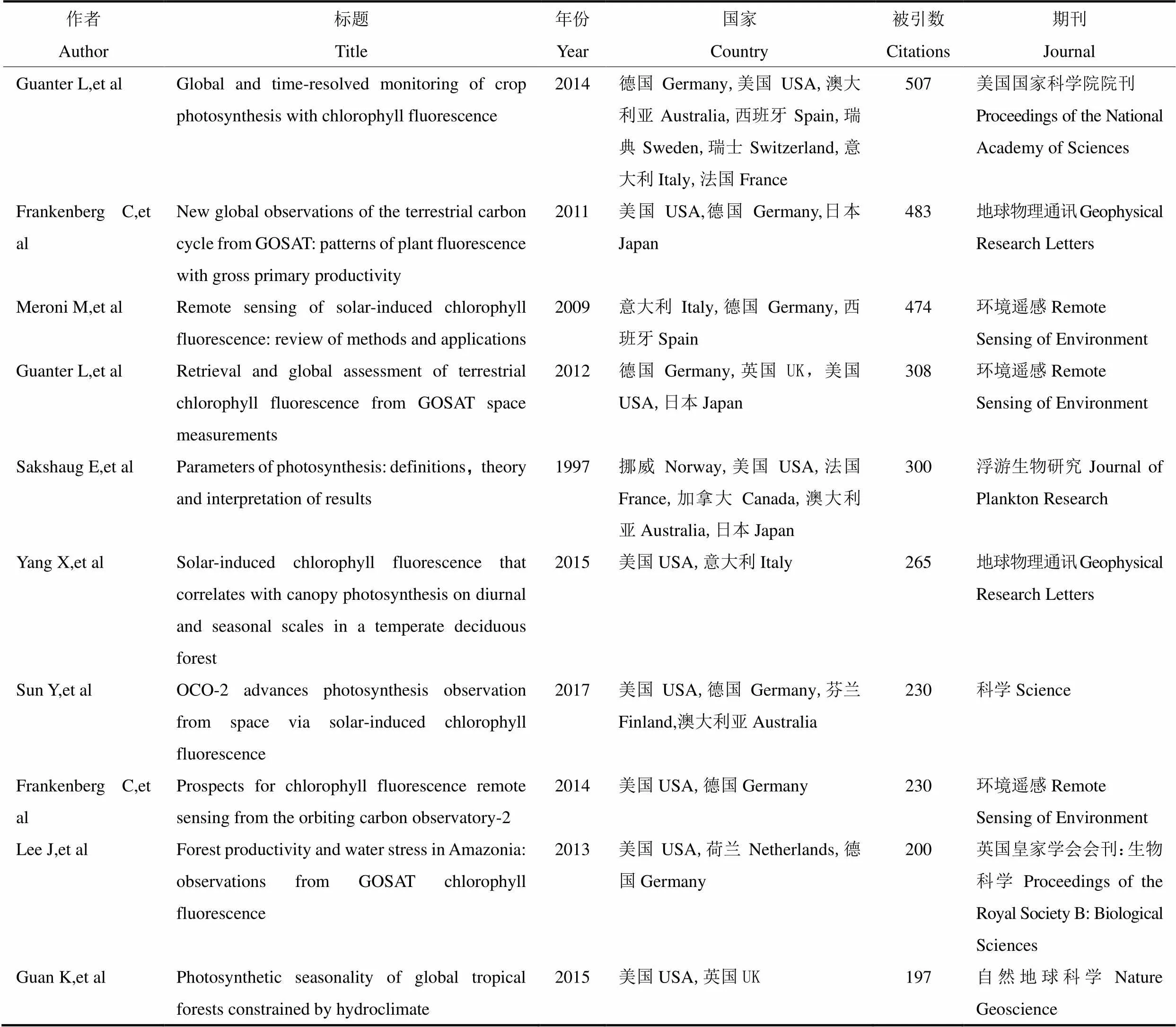
表1 关于SIF研究的前10篇最高被引论文
2.2 有关日光诱导叶绿素荧光的研究量分析
2.2.1 发文国家
共有67个国家发表了关于日光诱导叶绿素荧光(SIF)研究的文章。表2显示了在这一研究领域发表文章最多的15个国家/地区统计数据。其中美国发表文章数量最多(285篇),被引数也最多(10869次),并在SIF研究领域贡献了最多的国际合作发文量(181篇),同时美国还拥有最高的H指数(57),也是最早发表相关文章(1982年)的国家。德国是篇均被引数最高(56.2次)、与不同国家合作最多(36个)的国家,并在高被引文章数量(30篇论文被引超过100次)上与美国并列第一。中国在SIF研究领域的起步较晚(1994年),但发展迅速,到目前为止发表文章数(263篇)、相关作者数(636个)和机构数(280个)仅次于美国,但篇均被引数和高被引文章数量(≥引用100次的论文数)却低于美国、德国、意大利、西班牙、荷兰等国家,这表明中国在SIF领域的科研实力还有待加强,在增加发文数量的同时更要进一步提高文章的质量。在发表文章最多的15个国家/地区中,大多数国家通过国际合作发表的文章数高于无国际合作发表的文章数(MCP vs SCP),其中中国(131 vs 132)的SCP值和MCP值差异不大,而同为发展中国家的印度和波兰,其SCP值高于MCP值,发文量和被引数等指标也排名靠后。
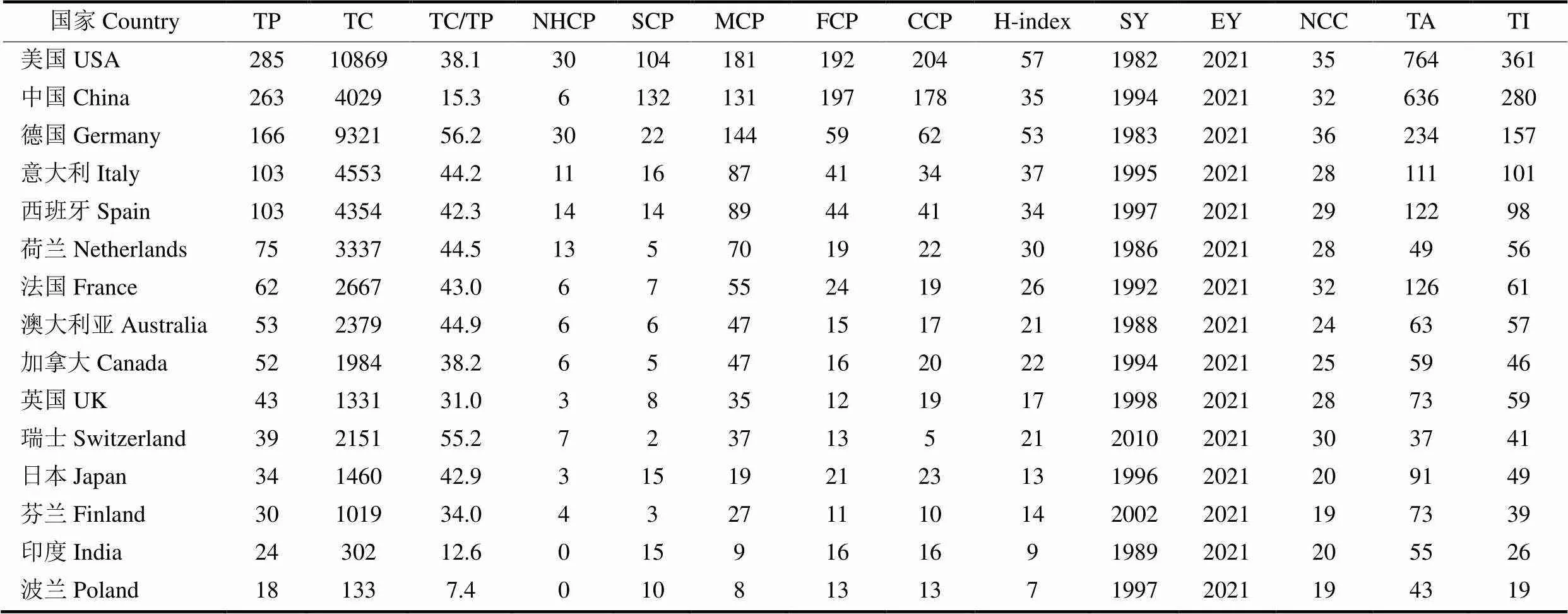
表2 关于SIF研究的15个最高产国家/地区的综合统计
注:TP是发表文章的总数量; TC是总被引数; TC/TP是篇均被引数; NHCP是高被引文章数量(≥引用100次); SCP和MCP分别是非国际合作和多国合作发表文章的数量; FCP和CCP分别是以此国家/地区为第一作者和通讯作者的国家/地区发表文章的数量; SY和EY分别是该国家首次和最后发表相关文章的年份; NCC是合作国家/地区的数量; TA是作者总数; TI是机构总数。
Note: TP is the total number of publications; TC is the total number of citations; TC/TP is citations per publication; NHCP is the number of highly cited publications (≥100 citations); SCP and MCP are the numbers of single- and multi-country publications, respectively; FCP and CCP are the numbers of first and corresponding country publications, respectively; SY and EY are the starting and ending publication years, respectively; NCC is the number of collaborative countries/regions; TA is the total number of authors; TI is the total number of institutions.
利用VOSviewer的国家合作分析功能绘制国家合作共现图谱,可以清楚地反映国家发文量和国家之间的合作强度。该分析展示了发表10篇以上文章的国家/地区的数据,得到共23个圆圈,197条连线,3个聚类的国家合作共现图谱。由图2可以看出,美国在SIF领域扮演着非常重要的角色,与众多国家均有密切的合作,其与中国的联系最为密切;德国对众多欧洲国家的研究有巨大的影响。总体而言同一大陆的国家联系更为紧密,西方国家与其他国家的合作也更为活跃。
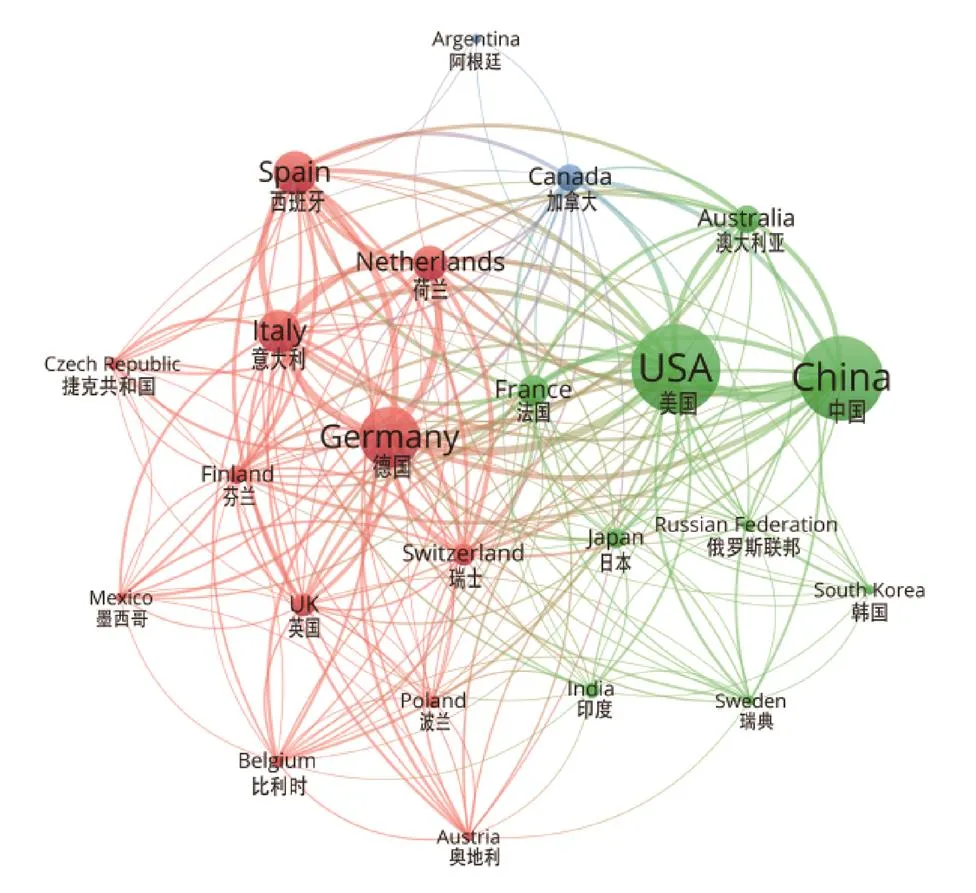
图2 关于SIF研究的主要国家/地区之间的学术合作Fig. 2 Academic cooperation among major countries/ regions on the research of SIF
注:图谱中共有3个聚类,23个圆圈,197条连线;不同颜色代表由不同国家/地区组成的聚类;圆圈代表不同国家/地区,圆圈越大表示该国家/地区发文数量越多;连线代表国家/地区之间的合作关系(不同国家作者出现在同一篇文献中),连线越粗表示合作越密切。
Note:There are 3 clusters, 23 circles, and 197 connecting lines. Colors represent clusters of different countries/regions. Circles represent different countries/regions, and bigger circles represent more articles published in this country/region. Lines represent the cooperative relationship between countries/regions (authors from different countries/regions appear in the same article), and thicker lines indicate more and closer cooperation between countries/regions.
2.2.2 发文机构
表3列出了在SIF研究领域发表文章最多的15个机构的发表统计数据。可以看到在排名前10的机构中美国和中国总共占了7个,其中南京大学发表的文章最多(61篇),但总被引数(1306次)却低于发文量相近的加州理工学院(3806次)。加州理工学院还拥有最高的高被引文章数量(13篇)和H指数(25)。篇均被引数最高(92.3次)的机构是发文量为35篇的美国卡内基科学研究所,其次是发文量为30篇的德国地球科学研究中心(86.8次),体现了其卓越的文献质量。同时美国卡内基科学研究所是最早(1982年)进行SIF研究的机构,为该领域的发展做出了突出的贡献。南京大学在该领域的研究主要由Zhang(张永光)团队完成,集中在运用模型估算SIF及其与GPP的关系[26−27]、SIF对植被光合能力的监测[28−30]等研究方向。加州理工学院的SIF研究主要由Frankenberg研究员团队完成,集中在通过遥感卫星实现对叶绿素荧光反演上[9,25,31−32]。
随着科学研究的不断发展,国际合作的加强,越来越多的研究是通过不同机构的相互合作完成的。由表3可见,多机构合作的文章发表数量明显高于单机构。其中,中国科学院大学、马克斯·普朗克生物地球化学研究所、苏黎世大学和多伦多大学发表的所有文章都是通过与其他机构的合作完成的。中国科学院遥感与数字地球研究所有着最多的单机构文章发表数量(8篇)。利用VOSviewer的机构合作分析功能,进一步分析各机构之间的合作共现。该分析展示了发表10篇以上文章的机构数据,得到共39个圆圈,270条连线,5个聚类的机构合作共现图谱。由图3可以看出,加州理工学院、南京大学和美国宇航局戈达德航天飞行中心均有着较为频繁的机构合作。同时各研究机构的合作关系有较强的地理相关性,尽管各机构不缺乏相当数量的国际合作,但从5种颜色对应5个不同的聚类来看,各机构还是与在同一国家/地区的其他机构更易组成聚类,联系也更密切些。
2.2.3 论文作者
共有2502名作者参与了SIF的相关研究。表4列出了该领域发表文章最多的10位作者的发文统计数据。由表可见,其中来自美国、中国、德国和西班牙的作者各有两位,还有两位分别来自意大利和荷兰,他们均为所在机构甚至所在国家SIF研究领域的领军人物。来自瓦伦西亚理工大学的Guanter有着最高的发文量(57篇)和总被引数(5073次),他还贡献了最多的高被引文章数量(21篇)和最高的H指数(34)。Guanter的研究方向集中于高光谱遥感研究,包括从遥感卫星中反演SIF[5,33−34]以及对植被光合作用的监测[8]等。来自美国宇航局戈达德航天飞行中心的Joiner拥有最高的篇均被引数(92.3次),在其所发表的35篇文献中有13篇高被引论文,他的研究方向同样为基于遥感卫星测量实现对叶绿素荧光的监测[6,35−36]。
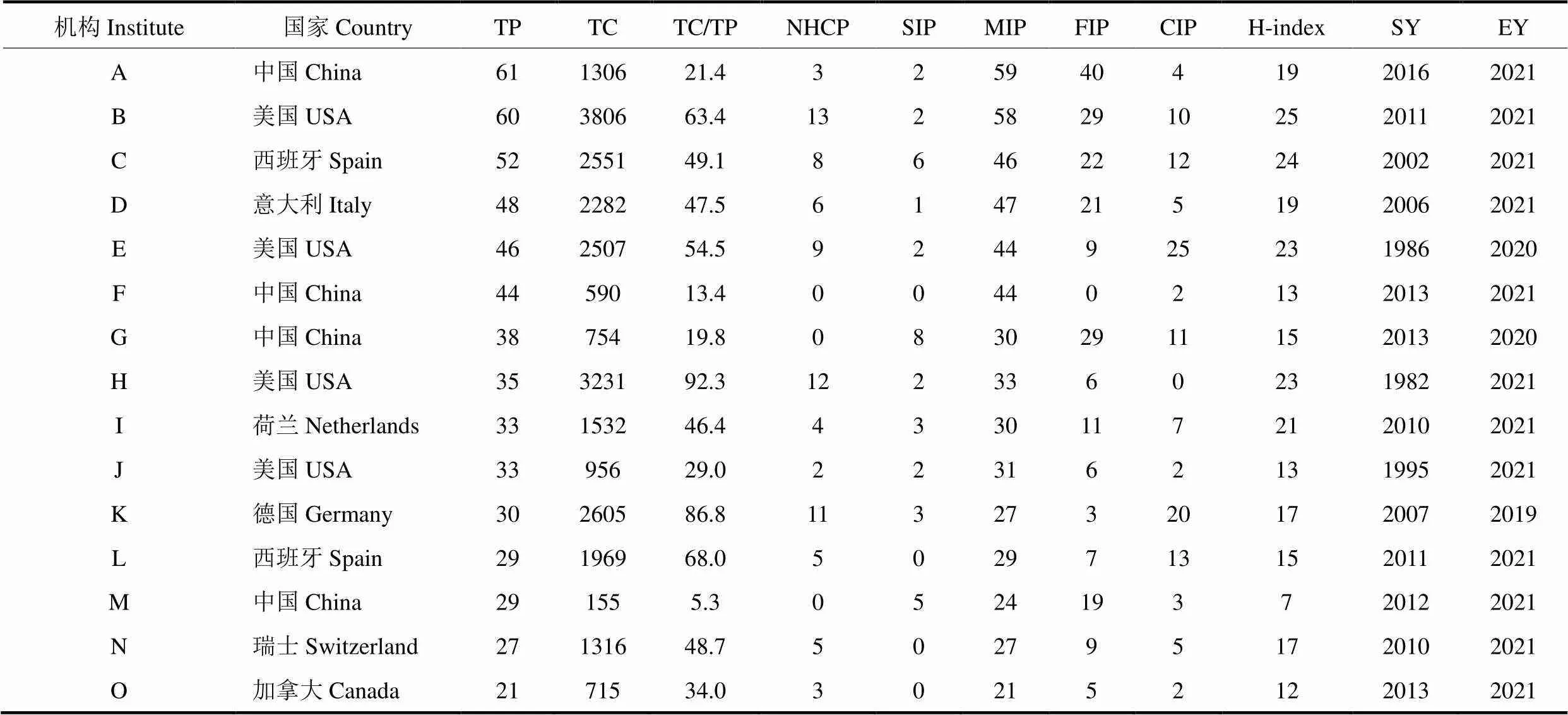
表3 关于SIF研究的15个最高产机构的综合统计
注:TP是发表文章的总数量;TC是总被引数;TC/TP是篇均被引数; NHCP是高被引文章数量(≥引用100次);SIP和MIP分别是单一机构和多机构合作发表文章的数量;FIP和CIP分别是以此机构作为第一作者和通讯作者单位的发表文章数量;SY和EY分别是该机构首次和最后发表相关文章的年份。A:南京大学;B:加州理工学院;C:瓦伦西亚大学;D:米兰-比科卡大学;E:美国宇航局戈达德航天飞行中心;F:中国科学院大学;G:中国科学院遥感与数字地球研究所;H:卡内基科学研究所;I:屯特大学;J:加利福尼亚大学;K:德国地球科学研究中心;L:马克斯•普朗克生物地球化学研究所;M:北京师范大学;N:苏黎世大学;O:多伦多大学;P:瓦伦西亚理工大学;Q:加州理工学院。下同。
Note: TP is the total number of publications; TC is the total number of citations; TC/TP is citations per publication; NHCP is the number of highly cited publications (≥100 citations); SIP and MIP are the numbers of single- and multi-institution publications, respectively; FIP and CIP are the numbers of first and corresponding institution publications, respectively; SY and EY are the starting and ending publication years, respectively. A:Nanjing University; B:California Institute of Technology; C:University of Valencia; D:University of Milano-Bicocca; E:NASA Goddard Space Flight Center; F:University of Chinese Academy of Sciences; G:Institute of Remote Sensing and Digital Earth,Chinese Academy of Sciences; H:Carnegie Institution for Science; I:University of Twente; J:University of California; K:German Research Center for Geosciences; L:Max Planck Institute for Biogeochemistry; M:Beijing Normal University; N:University of Zurich; O:University of Toronto; P:Polytechnic University of Valencia; Q:California Institute of Technology. The same as below.
图4为发表10篇以上文章的作者之间的合作共现图谱。57个作者可以分为5个聚类,共有541次联系。其中发文量最多的Guanter与其他作者的联系最为密切,并位于图谱的中心位置,他与Frankenberg、Zhang(张永光)、Rossini和van der Tol等高产作者均有比较密切的合作,体现了其在SIF研究领域的重要地位。中国科学院遥感与数字地球研究所的Liu (刘良云)团队也对SIF研究做出了突出贡献,主要研究方向是SIF的尺度转换及其与作物光合作用的关系[37−39],以及从中国CO2观测卫星任务TanSat实现SIF反演[40−41]。西北农林科技大学Lv(吕肖良)团队在SIF领域的贡献主要是基于较完备的实验系统来探究叶绿素荧光与光合作用的内在联系机制,改进SIF与GPP的关联模型,提高多尺度SIF评估光合活动的准确性[42−43]。
2.2.4 主要期刊
关于SIF的研究主要发表在地球科学、生态学、农学、植物生理学等领域的期刊上。表5列出了该领域发表文章最多的10种期刊的发表统计数据。其中Remote Sensing of Environment凭借92篇的发文量成为全球SIF研究领域发文量最高的期刊,该期刊2021年的影响因子为13.850,是遥感领域被普遍认可的顶级期刊之一。此外,该期刊还拥有最高的H指数(40),贡献了最多的高被引文章数量(15篇)。发表论文数排名第8位的Global Change Biology篇均被引次数最多(65.6次),其次是发表论文数排名第5位的Geophysical Research Letters,平均每篇被引次数为64次,这两种期刊各发表了6篇高被引文章数量,说明它们在该领域中具有较大的影响力。发表论文数排名第2位的Remote Sensing共发表了77篇关于SIF研究的文章,H指数为20,但篇均被引(13.6次)较低,且无高被引文章发表。发表论文数排名第3、4位的是两种会议期刊,分别为国际地球科学和遥感专题研讨会(IGARSS)和SPIE会议录−国际光学工程学会,它们开始SIF领域研究的时间都较早,分别为1993年和1992年。
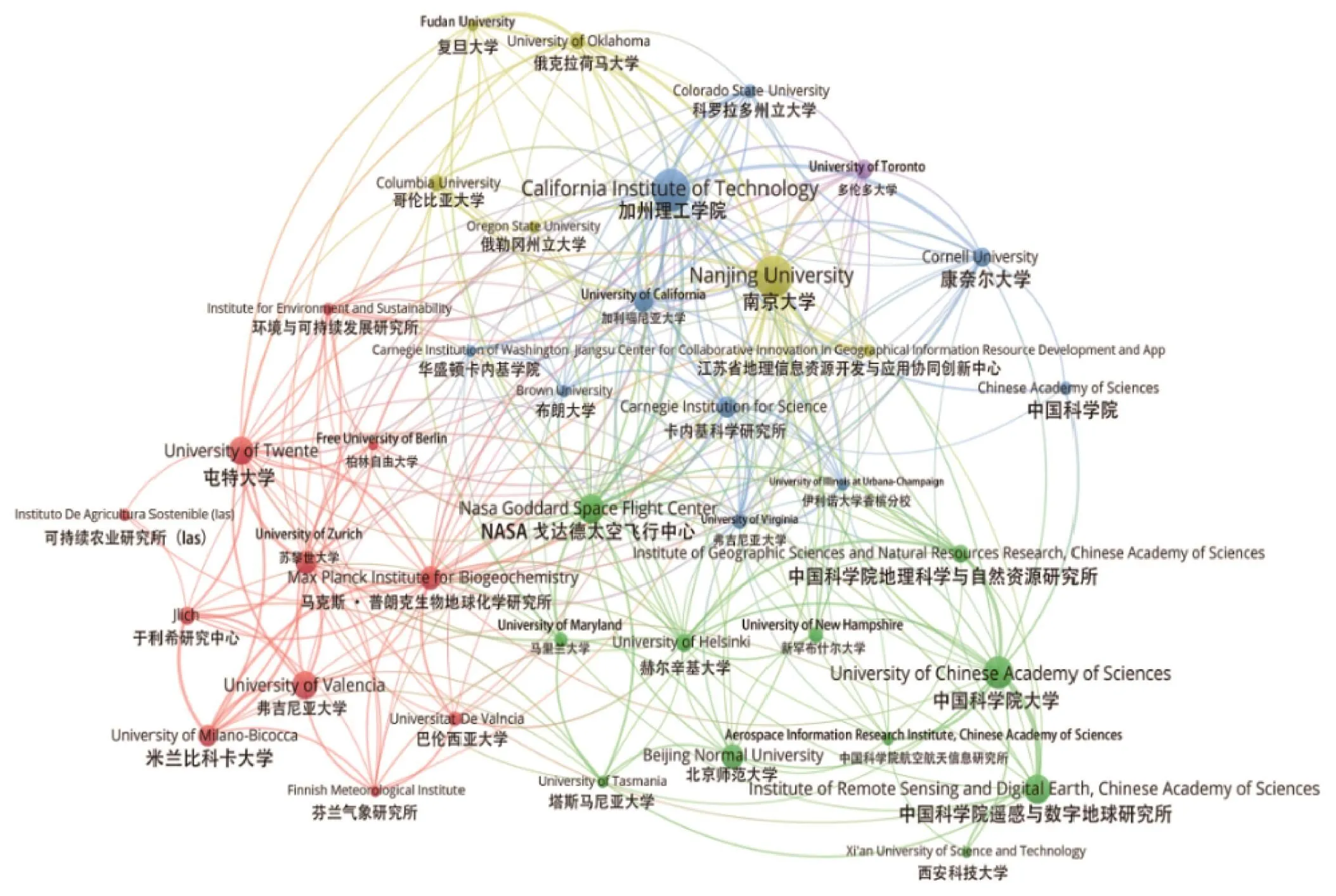
图3 关于SIF研究的主要机构之间的学术合作Fig. 3 Academic cooperation among major institutions on the research of SIF
注:图谱中共有5个聚类,39个圆圈,270条连线;不同颜色代表由不同研究机构组成的聚类;圆圈代表不同研究机构,圆圈越大表示该机构发文数量越多;连线代表研究机构之间的合作关系(不同机构作者出现在同一篇文献中),连线越粗表示合作越密切。
Note:There are 5 clusters, 39 circles, and 270 connecting lines. Colors represent clusters of different research institutions. Circles represent different research institutions, and bigger circles represent more articles published in this institution. Lines represent the cooperative relationship between research institutions (authors from different institutions appear in the same article), and thicker lines indicate more and closer cooperation between institutions.
2.3 有关日光诱导叶绿素荧光的研究热点关键词
2.3.1 关键词聚类
关键词是文献研究核心内容的浓缩与提炼,高频关键词分析可以反映该领域的研究发展和前沿变化以及该领域与其他领域的相关性[44]。本研究利用VOSviewer选取出现次数在10次以上的关键词进行共现分析,由图5可见,关键词总体聚类为4类,其中橙色聚类共有荧光、叶绿素、植被3个关键词,可看作SIF涉及的不同研究领域。
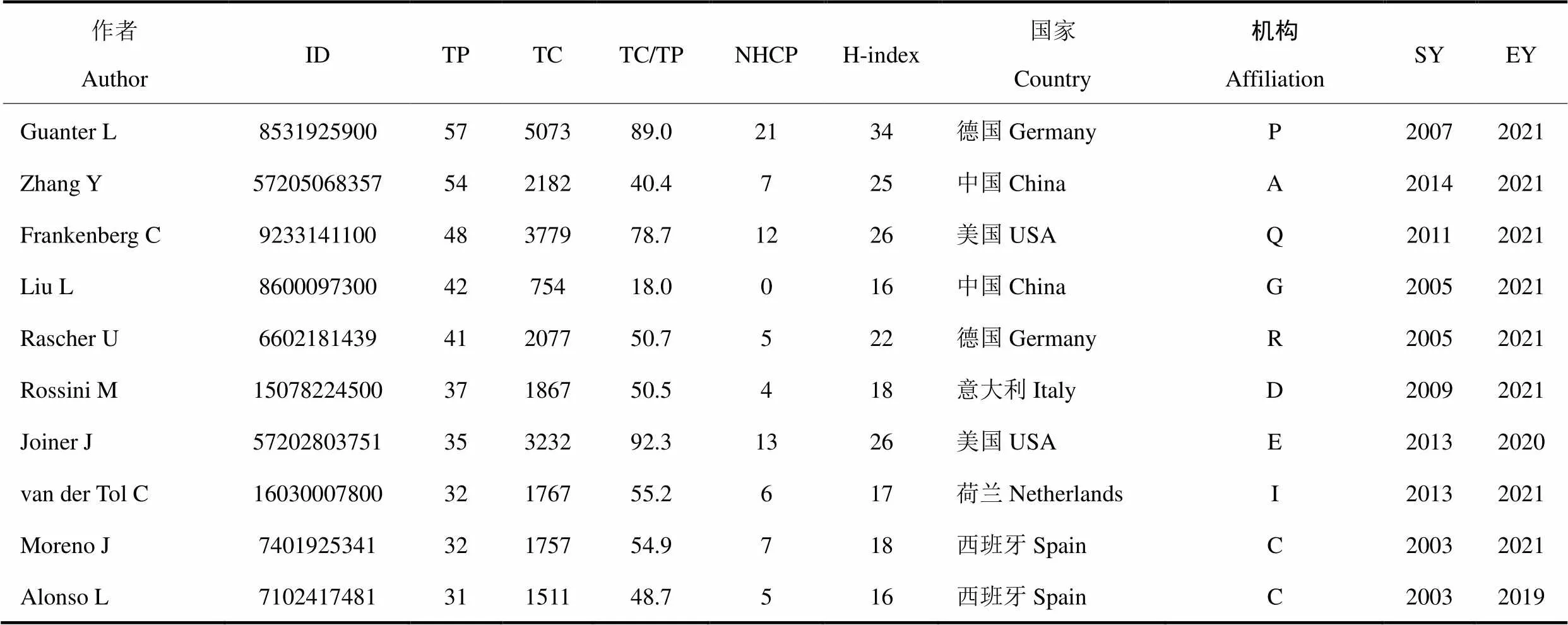
表4 关于SIF研究的10个最高产作者的综合统计
注:ID是Scopus为每个作者分配的唯一编号;TP是发表文章的总数量;TC是总被引数;TC/TP是篇均被引数; NHCP是高被引文章数量(≥引用100次);SY和EY分别是该作者首次和最后发表相关文章的年份;国家是该作者发文最多的所属机构所在国家;机构是该作者目前任职的机构。
Note: ID is the Scopus author identifier; TP is the total number of publications; TC is the total number of citations; TC/TP is citations per publication; NHCP is the number of highly cited publications (≥100 citations); SY and EY are the starting and ending publication years, respectively; The country is where the author published the most articles; The institution is where the author currently works.

图4 关于SIF研究的主要作者之间的学术合作
注:图谱中共有5个聚类,57个圆圈,541条连线;不同颜色代表由不同作者组成的聚类;圆圈代表不同作者,圆圈越大表示该作者发文数量越多;连线代表作者之间的合作关系(不同作者出现在同一篇文献中),连线越粗表示合作越密切。
Note:There are 5 clusters, 57 circles, and 541 connecting lines. Colors represent clusters of different authors. Circles represents different authors, and bigger circles represent more articles published by this author. Lines represent the cooperative relationship between authors (different authors appear in the same article), and thicker lines indicate more and closer cooperation between authors.
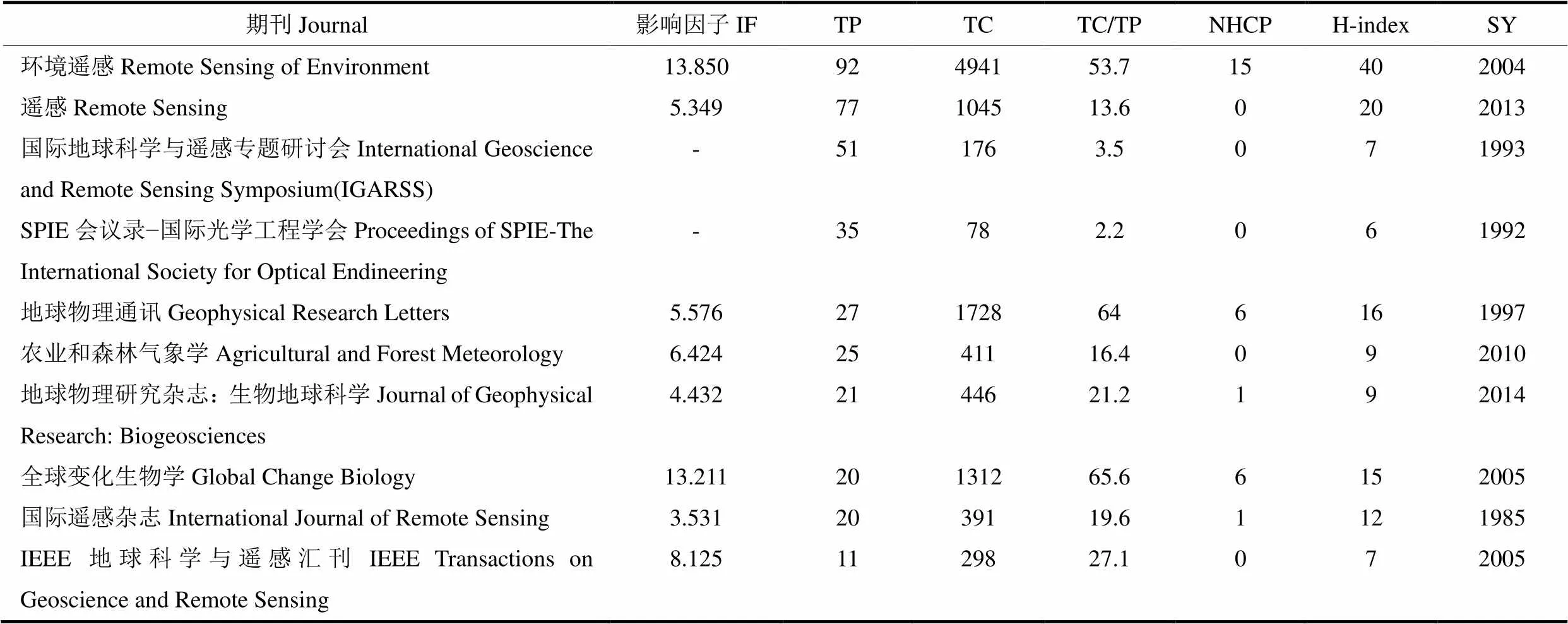
表5 关于SIF研究的10个最高产期刊的综合统计
注:IF为该期刊2021年度的影响因子;TP为发表文章的总数量;TC为总被引数;TC/TP为篇均被引次数; NHCP是高被引文章数量(≥引用100次);SY是该期刊首次发表相关文章的年份。
Note: IF is the impact factor of the journal in 2021; TP is the total number of publications; TC is the total number of citations; TC/TP is citations per publication; NHCP is the number of highly cited publications (≥100 citations); SY is the starting publication years.
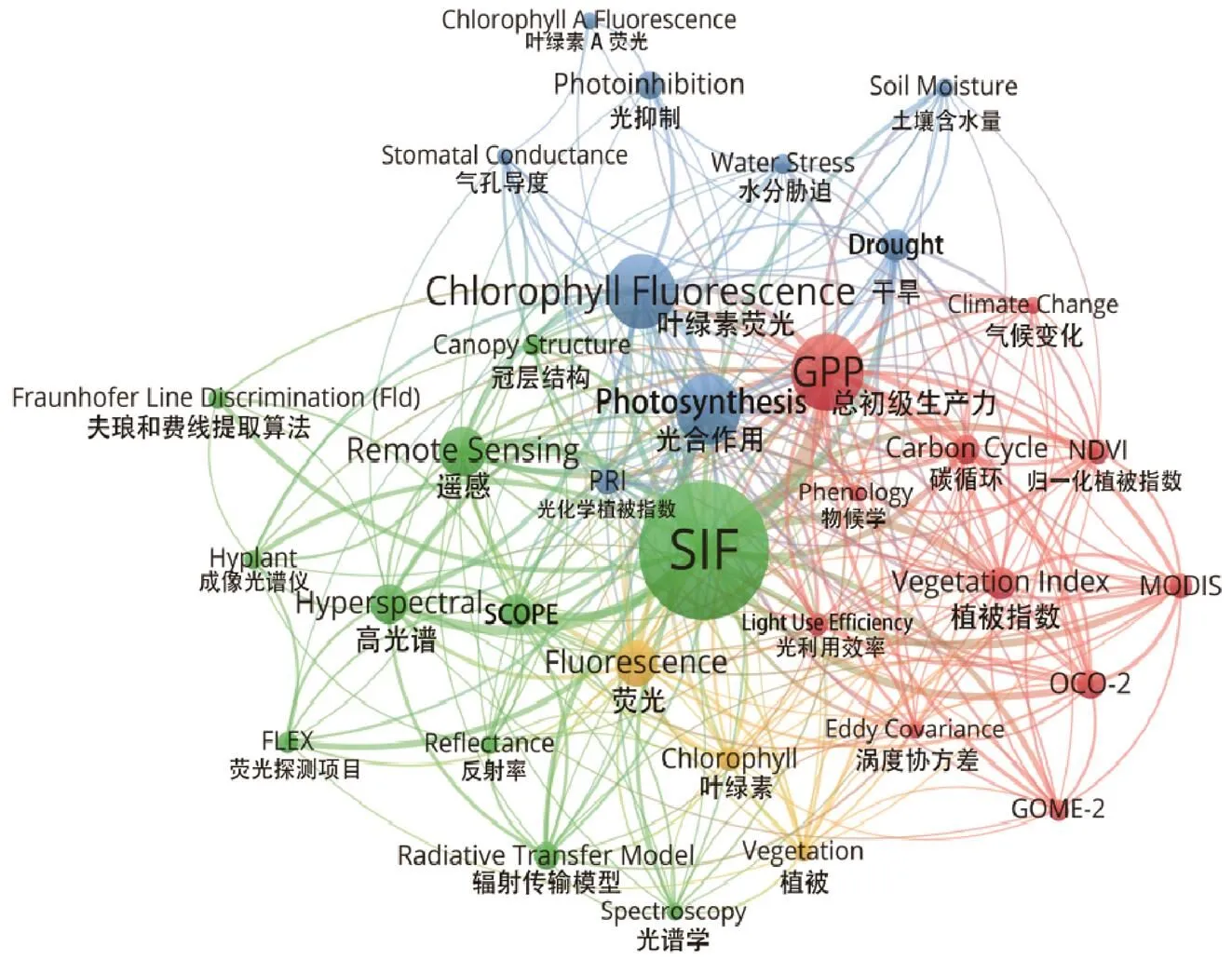
图5 关于SIF研究的关键词共现图谱
注:图谱中共有4个聚类,34个圆圈,288条连线;不同颜色代表由不同关键词组成的聚类;圆圈代表不同关键词,圆圈越大表示该关键词出现的频次越高;连线代表关键词之间的共现关系(不同关键词出现在同一篇文献中),连线越粗表示共现频次越高。
Note:There are 4 clusters, 34 circles, and 288 connecting lines. Colors represent clusters of different keywords. Circles represent different keywords, and bigger circles represent higher frequency of the keywords. Lines represent the co-occurrence relationship between keywords (different keywords appear in the same article), and thicker lines indicate higher and closer co-occurrence between keywords.
蓝色聚类共有9个关键词,主要包括叶绿素荧光、光合作用、干旱、光抑制、水分胁迫等,涉及叶绿素荧光的生理特性及胁迫监测等方面。在光系统水平,叶绿素荧光包括光系统I(PSI)和光系统II(PSII)荧光释放,通常认为PSII荧光与光合作用及热耗散NPQ(nonphotochemical quenching)过程相互关联[12],其分别对应的荧光效率、光化学效率以及NPQ效率在能量分配上具有紧密的机理联系[45]。因此叶绿素荧光可以看作指示植被光合作用强弱的理想“探针”,在量化光合碳同化量、表征植物生理健康状态及指示光合所受胁迫程度大小的相关研究方面有着巨大的应用潜力[46]。例如,在叶片尺度上,研究人员基于盆栽或田间水分胁迫实验,发现荧光参数对水分胁迫响应迅速,水分亏缺的生理效应会导致光化学效率和荧光效率显著下降[47−50]。同样在高温胁迫下,荧光效率表现为降低的趋势[51−52]。而在低温条件下,光合活性降低使得大部分叶片光化学效率降低,同时NPQ降低,从而导致荧光效率升高[53]。近年来SIF研究在区域及全球尺度的胁迫监测方面也取得了重要进展。与传统基于反射率的植被“绿度”指数不同,植被冠层遥感SIF对环境胁迫的响应更加敏感[54]。遥感SIF在干旱和水分胁迫下表现出显著的下降趋势[54−56],水分胁迫下植被生产力的变化与荧光效率的相关性高于与传统植被指数的相关性[55],可能是因为传统植被指数存在“饱和”现象,从而无法及时检测到由环境胁迫引起的植被光合生理的快速变化[57]。在不同空间尺度(光系统、叶片、冠层、区域遥感)下,由于叶绿素荧光能够对植被光合作用的变化做出及时响应,使得SIF在植物生理、生态及遥感领域得到广泛应用。
绿色聚类共有11个关键词,主要包括SIF、遥感、高光谱、辐射传输模型、SCOPE等,涉及SIF的获取方式等方面。SIF数据最初是由地面光谱仪测量得到,随着携带高光谱传感器遥感卫星的发展以及荧光探测项目FLEX的推进,近十年研究人员已经从多个航空和卫星高光谱遥感数据中成功反演了SIF[7,25,31−32,35,40,58−59]。遥感反演SIF算法多基于夫琅和费线提取算法FLD(fraunhofer line discrimination)[60],总体可以分为两类,即基于大气辐射传输机理过程的反演算法[25,58,61−62]和基于统计的反演算法[31,35,63]。由于SIF的激发及辐射传输过程受多重因素影响,在叶片、冠层和生态系统尺度上,SIF对环境因子(光照、温度、饱和水汽压差等)和光合生理因素的响应均较为复杂,因此,研究者们通过构建不同尺度的SIF辐射传输模型,来研究叶片生理和冠层结构以及不同环境因子对SIF辐射传输和光合作用的耦合程度,从而更好地解释和利用SIF遥感信号。其中最为典型的是一维冠层荧光辐射传输SCOPE(Soil Canopy Observation,Photochemistry and Energy fluxes)模型[64],该模型在考虑土壤背景影响的条件下,将荧光从叶片到冠层的辐射传输过程与光合作用机理耦合进行综合模拟[65−66],目前是FLUXNET团队利用通量数据估测辐射传输过程的主要模型工具之一[37]。
图5中红色聚类共有11个关键词,主要包括GPP、植被指数、碳循环和气候变化和物候学等,主要涉及SIF的遥感应用(如碳循环)方面。GPP是表征生物圈和大气圈能量平衡的重要变量之一[67]。在估算陆地生态系统GPP方面,应用遥感数据的光能利用率LUE模型是当前的主流方法之一[68],由于SIF与GPP均是由冠层吸收的光合有效辐射APAR驱动,因此具有较强的相关性[69],通过塔基光谱仪的观测表明,SIF与APAR、LUE、GPP的日变化和季节变化具有一致性和相关性[70−73],同时在遥感尺度上,可通过GOSAT、GOME-2、OCO-2和TROPOMI等传感器反演得到的SIF遥感数据[25,31−32,35]来快速精确地估算植被GPP,其估算精度优于采用传统植被指数(如NDVI)的估算方法[8,74],在农业生产力及作物产量估算方面发挥着重要作用。在大气CO2浓度监测方面,卫星SIF数据可以很好地模拟CO2的季节性变化,并且可以对厄尔尼诺、拉尼娜等大气环流异常现象做出及时的响应[72,75−77]。在追踪植被的物候信息方面,SIF由于同时包含了物候信息和荧光效率所反映的胁迫状况信息,同样被广泛应用于捕捉植被的季节性变化[69,73,78],用以提高全球光合模型精度[56,79−80]以及揭示植被−气候交互作用等[81−82]。
2.3.2 学科发展
由于2011年首次在全球尺度实现SIF卫星遥感反演,因此被称为“SIF元年”。将1982−2021年分为1982−2010、2011−2015和2016−2021年3个研究时期,选取各时期内出现次数在5次以上的作者关键词进行共现分析(图6),以探究某一时期内SIF的研究热点与应用特点。
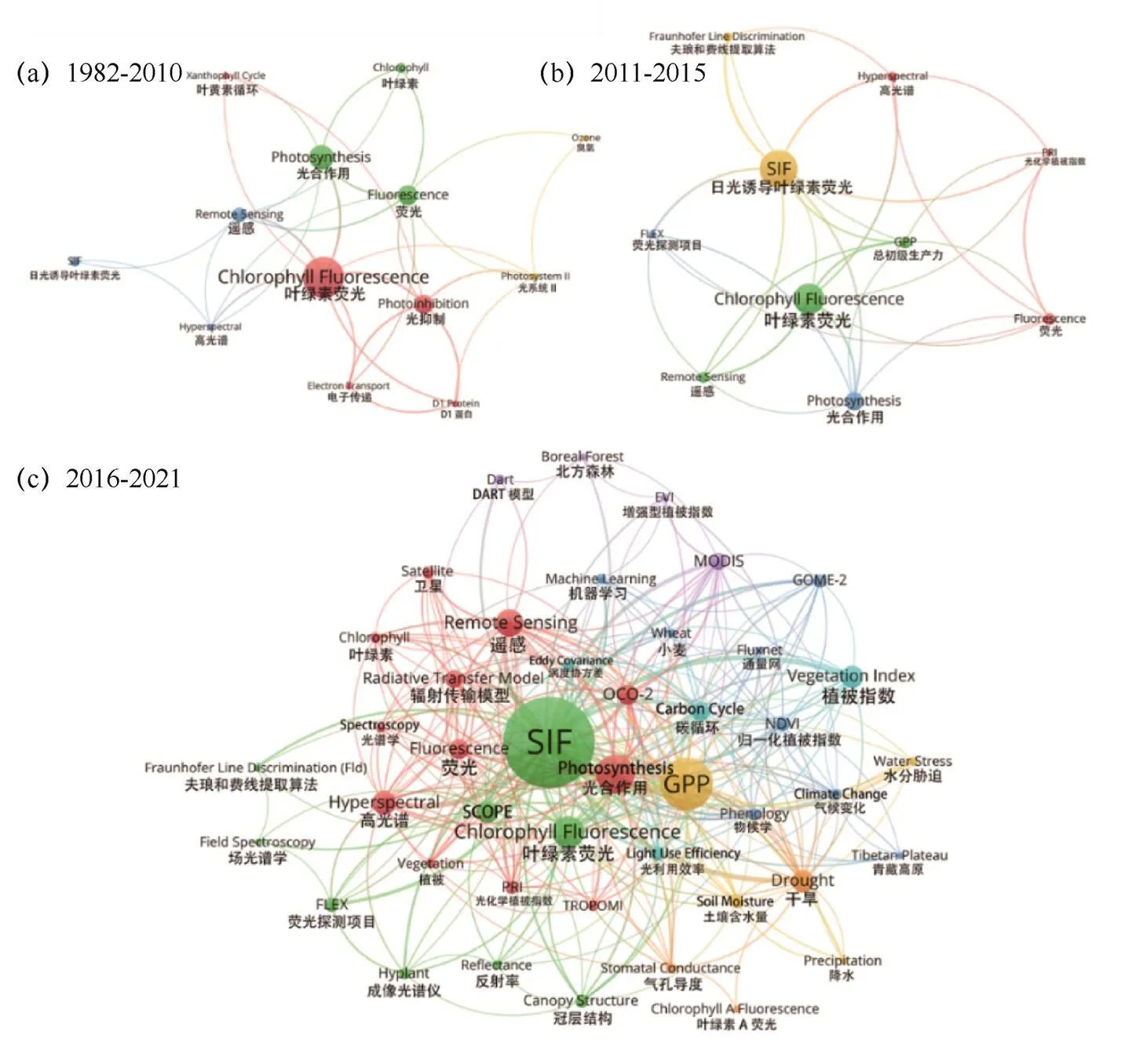
图6 1982−2010年(a)、2011−2015年(b)、2016−2021年(c)关于SIF研究的关键词共现图谱Fig. 6 The co-occurrence map of keywords on the research of SIF during 1982−2010(a)、2011−2015(b)、2016−2021(c)
注:不同颜色代表由不同关键词组成的聚类;圆圈代表不同关键词,圆圈越大表示该关键词出现的频次越高;连线代表关键词之间的共现关系(不同关键词出现在同一篇文献中),连线越粗表示共现频次越高。
Note:Colors represent clusters of different keywords. Circles represent different keywords, and bigger circles represent higher frequency of the keywords. Lines represent the co-occurrence relationship between keywords (different keywords appear in the same article), and thicker lines indicate higher and closer co-occurrence between keywords.
从3个研究时期作者关键词的共现图谱中,可以归纳出SIF研究的大致发展特点:(1)1982−2010年的关键词(图6a)主要是叶绿素荧光、荧光、光合作用、光抑制等,此时的研究大多是通过叶绿素荧光来探究植物的生理特性或过程,如光系统II、电子传递速率、叶黄素循环等。遥感作为关键词的出现,说明高光谱技术和卫星遥感技术在当时也已得到发展并应用于SIF研究。(2)2011−2015年(图6b)开始出现GPP、FLEX、FLD等词,这表明伴随着全球高光谱传感器的发展,特别是Frankenberg等[25]利用日本温室气体观测卫星GOSAT首次从太空观测到全球陆地叶绿素荧光的季节变化,并反演出全球首张陆地SIF地图后,大尺度SIF的空间反演以及光合作用总初级生产力的量化评估等研究开始稳步发展,SIF的研究不再停留于生理层面,开始面向实际应用。(3)2016−2021年的关键词(图6c)相比前两时期明显增加,表明近年来关于SIF研究的发展迅速且全面。高频关键词SCOPE的出现说明应用模型已成为估测辐射传输过程的常用方法。在全球气候变化背景下,碳循环、气候变化、干旱、水分胁迫、物候等关键词即为当前SIF研究的热点领域。
3 结论与展望
3.1 结论
作为植被遥感领域最具突破性的研究前沿之一,SIF的研究已进入蓬勃发展阶段。从研究结果来看,美国、德国、意大利等发达国家在SIF领域的研究实力处于领先地位。Remote Sensing of Environment、Geophysical Research Letters和Global Change Biology等优质期刊都发表了大量SIF领域的研究成果。文献关键词聚类的结果表明,光合作用、GPP、叶绿素荧光、遥感、碳循环和高光谱等是SIF领域的研究热点词汇,主要涉及三个方面:叶绿素荧光的生理特性及胁迫监测、SIF的获取方式和SIF的遥感应用(如碳循环),这也大致对应了SIF研究领域的学科发展过程。
中国的相关研究起步较晚,但在众多优秀研究者的努力下发展迅速,当前发文数高居全球第二,且在Remote Sensing of Environment等期刊上发表过大量优秀论文,现如今整体研究实力走在世界前列。在未来研究中,中国研究者仍需加强与其他国家的合作,在增加文章发表数量的同时注重提高研究质量,进一步提高研究的影响力。
3.2 问题与展望
本研究基于文献计量分析和可视化计量分析,系统总结了1982−2021年SIF领域的发展趋势,并从国家、机构、作者、期刊和关键词等方面进行了分析,为深入了解SIF研究提供一个全面的视角。相关结论将有助于后续研究更明确地开展研究选题、创新研究方法,并为其他领域开展此类文献计量学研究提供一定借鉴。分析中所使用的英文文献数据来自Scopus数据库,重点考虑了世界范围内SIF领域的基本研究情况,但会导致对非英语国家研究水平的低估。在文献检索时,检索条件设置为同时满足“sun induced”和“chlorophyll fluorescence”或其同义词,但检索到的早期文献主要是考虑到太阳光照影响的叶绿素荧光研究,并非当前研究严格意义上的SIF。此外,一些作者可能先后任职于不同机构,一些机构的名称在不同文献中可能也有差异,这会影响作者和机构的综合统计分析结果。未来的相关研究可结合Scopus与Web of Science、CNKI和CSCD等数据库,着重进行SIF领域热点演变的对比探讨,深入全面分析该领域的发展特点。
随着理论的不断完善,高光谱技术和卫星遥感技术的快速发展,当前SIF研究空间尺度更大,数据更精确,研究视角更深入透彻。但SIF数据仍然存在空间分辨率较粗、信号噪声较大以及提取算法存在局限性等问题,为了提高模型模拟精度并扩大荧光遥感的应用范围,未来可在以下几个方向着重开展相关研究:(1)进一步发展SIF卫星遥感传感器技术,在提高传感器信噪比的同时,尽可能提高时空分辨率;(2)深入研究SIF与植物光合生理过程的关联机理,明确不同时空尺度条件、不同生态系统类型下的SIF和GPP内在机理关系;(3)耦合荧光模型与其他生态系统模型,优化模型关键参数,加快SIF数据产品的生产,并结合多源遥感数据和机器学习等方法扩展SIF数据的应用范围。以上研究方向将有助于更好地观测植被生长状态,准确预测粮食产量,保障国家粮食安全,并在全球气候变化的大背景下为中国实现“碳达峰”和“碳中和”愿景提供可靠的估算依据。
[1] Lichtenthaler H K,Buschmann C,Rinderle U,et al. App- lication of chlorophyll fluorescence in ecophysiology[J]. Radiation and Environmental Biophysics,1986,25(4):297- 308.
[2] Gu L,Han J,Wood J D,et al.Sun-induced Chl fluorescence and its importance for biophysical modeling of photo- synthesis based on light reactions[J].New Phytologist, 2019,223(3):1179-1191.
[3] 刘良云.植被定量遥感原理与应用[M].北京:科学出版社, 2014.
Liu L Y.Principle and application of vegetation quantitative remote sensing[M].Beijing:Science Press,2014.(in Chinese)
[4] 章钊颖,王松寒,邱博,等.日光诱导叶绿素荧光遥感反演及碳循环应用进展[J].遥感学报,2019,23(1):37-52.
Zhang Z Y,Wang S H,Qiu B,et al.Retrieval of sun-induced chlorophyll fluorescence and advancements in carbon cycle application[J].Journal of Remote Sensing,2019,23(1):37- 52.(in Chinese)
[5] Guanter L,Frankenberg C,Dudhia A,et al.Retrieval and global assessment of terrestrial chlorophyll fluorescence from GOSAT space measurements[J].Remote Sensing of Environment,2012,121:236-251.
[6] Joiner J,Yoshida Y,Vasilkov A P,et al.First observations of global and seasonal terrestrial chlorophyll fluorescence from space[J].Biogeosciences,2011,8(3):637-651.
[7] Joiner J,Yoshida Y,Vasilkov A P,et al.Filling-in of near-infrared solar lines by terrestrial fluorescence and other geophysical effects: simulations and space-based observations from SCIAMACHY and GOSAT[J]. Atmospheric Measurement Techniques,2012,5(4):809- 829.
[8] Guanter L,Zhang Y,Jung M,et al.Global and time-resolved monitoring of crop photosynthesis with chlorophyll fluorescence[J].Proceedings of the National Academy of Sciences,2014,111(14):E1327-1333.
[9] Sun Y,Frankenberg C,Wood J D,et al.OCO-2 advances photosynthesis observation from space via solar-induced chlorophyll fluorescence[J].Science,2017,358(6360):m5747.
[10] Mohammed G H,Colombo R,Middleton E M,et al.Remote sensing of solar-induced chlorophyll fluorescence (SIF) in vegetation: 50 years of progress[J].Remote Sensing of Environment,2019,231:111177.
[11] Van Kooten O,Snel J F.The use of chlorophyll fluorescence nomenclature in plant stress physiology[J].Photosynthesis Research,1990,25(3):147-150.
[12] Krause G H,Weis E.Chlorophyll fluorescence and photosynthesis:the basics[J].Annual Review of Plant Biology,1991,42(1):313-349.
[13] Maxwell K,Johnson G N.Chlorophyll fluorescence-a practical guide[J].Journal of Experimental Botany,2000, 51(345):659-668.
[14] Meroni M,Rossini M,Guanter L,et al.Remote sensing of solar-induced chlorophyll fluorescence: Review of methods and applications[J].Remote Sensing of Environment, 2009,113(10):2037-2051.
[15] 詹春晖,章钊颖,张永光.日光诱导叶绿素荧光辐射传输模型研究进展[J].遥感学报,2020,24(8):945-957.
Zhan C H,Zhang Z Y,Zhang Y G.Recent advances in the radiative transfer models of sun-induced chlorophyll fluorescence[J].Journal of Remote Sensing,2020,24(8): 945-957.(in Chinese)
[16] 孙忠秋,高显连,杜珊珊,等.全球日光诱导叶绿素荧光卫星遥感产品研究进展与展望[J].遥感技术与应用,2021, 36(5):1044-1056.
Sun Z Q,Gao X L,Du S S,et al.Research progress and prospective of global satellite based solar-induced chlorophyll fluorescence products[J].Remote Sensing Technology and Application,2021,36(5):1044-1056.(in Chinese)
[17] Falagas M,Pitsouni E,Malietzis G,et al.Comparison of PubMed, Scopus, Web of Science, and Google Scholar: strengths and weaknesses[J].Faseb Journal Official Publication of the Federation of American Societies for Experimental Biology,2008,22(2):338-342.
[18] Li J,Wang L,Liu Y,et al.The research trends of metal-organic frameworks in environmental science:a review based on bibliometric analysis[J].Environmental Science and Pollution Research,2020,27(16):19265-19284.
[19] Zhang Y,Yu Q,Li J.Bioenergy research under climate change:a bibliometric analysis from a country perspective[J].Environmental Science and Pollution Research,2021,28(21):26427-26440.
[20] Hirsch J E.An index to quantify an individual's scientific research output[J].Proceedings of the National Academy of Sciences,2005,102:16569-16572.
[21] Zhang Y,Yu Q.What is the best article publishing strategy for early career scientists[J].Scientometrics,2020,122(1): 397-408.
[22] Aria M,Cuccurullo C.Bibliometrix:an R-tool for comprehensive science mapping analysis[J].Journal of Informetrics,2017,11(4):959-975.
[23] Van Eck N,Waltman L.Software survey:VOSviewer,a computer program for bibliometric mapping[J]. Scientometrics, 2010,84(2):523-538.
[24] 宋秀芳,迟培娟.Vosviewer与Citespace应用比较研究[J].情报科学,2016,34(7):108-112.
Song X F,Chi P J.Comparative study of the data analysis results by Vosviewer and Citespace[J].Information Science, 2016,34(7):108-112.(in Chinese)
[25] Frankenberg C,Fisher J B,Worden J,et al.New global observations of the terrestrial carbon cycle from GOSAT: Patterns of plant fluorescence with gross primary productivity [J].Geophysical Research Letters,2011,38(17):L17706.
[26] Zhang Y,Guanter L,Berry J A,et al.Model-based analysis of the relationship between sun-induced chlorophyll fluorescence and gross primary production for remote sensing applications[J].Remote Sensing of Environment, 2016,187:145-155.
[27] Zhang Y,Guanter L,Berry J A,et al.Estimation of vegetation photosynthetic capacity from space-based measurements of chlorophyll fluorescence for terrestrial biosphere models[J]. Global Change Biology,2014,20(12):3727-3742.
[28] Zhang Y,Xiao X,Jin C,et al.Consistency between sun-induced chlorophyll fluorescence and gross primary production of vegetation in North America[J].Remote Sensing of Environment,2016,183:154-169.
[29] Yang H,Yang X,Zhang Y,et al.Chlorophyll fluorescence tracks seasonal variations of photosynthesis from leaf to canopy in a temperate forest[J].Global Change Biology, 2017,23(7):2874-2886.
[30] Shan N,Zhang Y,Chen J M,et al.A model for estimating transpiration from remotely sensed solar-induced chlorophyll fluorescence[J].Remote Sensing of Environment, 2021,252:112134.
[31] Frankenberg C,O'Dell C,Berry J,et al.Prospects for chlorophyll fluorescence remote sensing from the Orbiting Carbon Observatory-2[J].Remote Sensing of Environment, 2014,147:1-12.
[32] Köhler P,Frankenberg C,Magney T S,et al.Global retrievals of solar-induced chlorophyll fluorescence with TROPOMI: first results and intersensor comparison to OCO-2[J]. Geophysical Research Letters,2018,45(19):10- 456.
[33] Guanter L,Rossini M,Colombo R,et al.Using field spectroscopy to assess the potential of statistical approaches for the retrieval of sun-induced chlorophyll fluorescence from ground and space[J].Remote Sensing of Environment,2013,133:52-61.
[34] Guanter L,Bacour C,Schneider A,et al.The TROPOSIF global sun-induced fluorescence dataset from the Sentinel-5P TROPOMI mission[J].Earth System Science Data,2021,13(11):5423-5440.
[35] Joiner J,Guanter L,Lindstrot R,et al.Global monitoring of terrestrial chlorophyll fluorescence from moderate-spectral- resolution near-infrared satellite measurements:methodology, simulations,and application to GOME-2[J].Atmospheric Measurement Techniques,2013,6(10):2803-2823.
[36] Joiner J,Yoshida Y,Köehler P,et al.Systematic orbital geometry-dependent variations in satellite solar-induced fluorescence (SIF) retrievals[J].Remote Sensing,2020,12 (15):2346.
[37] Liu L,Liu X,Wang Z,et al.Measurement and analysis of bidirectional SIF emissions in wheat canopies[J].IEEE Transactions on Geoscience and Remote Sensing,2015,54 (5):2640-2651.
[38] Liu L,Guan L,Liu X.Directly estimating diurnal changes in GPP for C3 and C4 crops using far-red sun-induced chlorophyll fluorescence[J].Agricultural and Forest Meteorology, 2017,232:1-9.
[39] Liu X,Guanter L,Liu L,et al.Downscaling of solar-induced chlorophyll fluorescence from canopy level to photosystem level using a random forest model[J].Remote Sensing of Environment,2019,231:110772.
[40] Du S,Liu L,Liu X,et al.Retrieval of global terrestrial solar-induced chlorophyll fluorescence from TanSat satellite[J].Science Bulletin,2018,63(22):1502-1512.
[41] Ma Y,Liu L,Chen R,et al.Generation of a global spatially continuous TanSat solar-induced chlorophyll fluorescence product by considering the impact of the solar radiation intensity[J].Remote Sensing,2020,12(13):2167.
[42] Lu X,Liu Z,Zhao F,et al.Comparison of total emitted solar-induced chlorophyll fluorescence (SIF) and top-of-canopy (TOC) SIF in estimating photosynthesis[J]. Remote Sensing of Environment,2020,251:112083.
[43] Liu Z,Zhao F,Liu X,et al.Direct estimation of photosynthetic CO2 assimilation from solar-induced chlorophyll fluorescence (SIF)[J].Remote Sensing of Environment,2022,271: 112893.
[44] 黄承芳,李宁,刘丽,等.气候变化下农业领域的国际文献特征与热点演变:基于CiteSpace V的文献计量分析[J].中国农业气象,2019,40(8):477-488.
Huang C F,Li N,Liu L,et al.International literature characteristics and hotspots evolution of agricultural under climate change:bibliometrics analysis based on CiteSpace V[J].Chinese Journal of Agrometeorology,2019,40(8):477- 488.(in Chinese)
[45] 程占慧,刘良云.基于叶绿素荧光发射光谱的光能利用率探测[J].农业工程学报,2010(S2):74-80.
Cheng Z H,Liu L Y.Detection of vegetation light use efficiency based on chlorophyll fluorescence spectrum[J]. Transactions of the Chinese Society of Agricultural Engineering.2010(S2):74-80.(in Chinese)
[46] Baker N R.Chlorophyll fluorescence:a probe of photosynthesis in vivo[J].Annual Review of Plant Biology,2008,59:89- 113.
[47] Cendrero-Mateo M P,Carmo-Silva A E,Porcar-Castell A,et al.Dynamic response of plant chlorophyll fluorescence to light,water and nutrient availability[J].Functional Plant Biology,2015,42(8):746-757.
[48] 张曼义,杨再强,侯梦媛.土壤水分胁迫对设施黄瓜叶片光合及抗氧化酶系统的影响[J].中国农业气象,2017,38(1): 21-30.
Zhang M Y,Yang Z Q,Hou M Y.Effects of soil water stress on photosynthetic characteristics and antioxidant enzyme system of cucumber leaves in greenhouse[J].Chinese Journal of Agrometeorology,2017,38(1):21-30.(in Chinese)
[49] Galmés J,Medrano H,Flexas J.Photosynthetic limitations in response to water stress and recovery in Mediterranean plants with different growth forms[J].New Phytologist, 2007,175(1):81-93.
[50] Dobrowski S Z,Pushnik J C,Zarco-Tejada P J,et al.Simple reflectance indices track heat and water stress-induced changes in steady-state chlorophyll fluorescence at the canopy scale[J].Remote Sensing of Environment,2005,97(3): 403-414.
[51] 陆思宇,杨再强,张源达,等.高温条件下光周期对鲜切菊花叶片光合系统荧光特性的影响[J].中国农业气象,2020, 41(10):632-643.
Lu S Y,Yang Z Q,Zhang Y D,et al.Effect of Photoperiod on fluorescence characteristics of photosynthetic system of fresh-cut chrysanthemum leaves under high temperature[J]. Chinese Journal of Agrometeorology,2020,41(10):632- 643.(in Chinese)
[52] 胡文海,胡雪华,闫小红,等.低温胁迫及恢复对番茄快速叶绿素荧光诱导动力学特征的影响[J].中国农业气象, 2021,42(10):859-869.
Hu W H,Hu X H,Yan X H,et al.Response of chlorophyll fluorescence transient in leaves of tomato under chilling stress and subsequent recovery[J].Chinese Journal of Agrometeorology,2021,42(10):859-869.(in Chinese)
[53] Pérez-Priego O,Zarco-Tejada P J,Miller J R,et al.Detection of water stress in orchard trees with a high-resolution spectrometer through chlorophyll fluorescence in-filling of the O2-A band[J].IEEE Transactions on Geoscience and Remote Sensing,2005,43(12):2860-2869.
[54] Lee J,Frankenberg C,van der Tol C,et al.Forest productivity and water stress in Amazonia:observations from GOSAT chlorophyll fluorescence[J].Proceedings of the Royal Society B:Biological Sciences,2013,280(1761):20130171.
[55] Wagle P,Zhang Y,Jin C,et al.Comparison of solar-induced chlorophyll fluorescence,light-use efficiency,and process- based GPP models in maize[J].Ecological Applications, 2016,26(4):1211-1222.
[56] Yoshida Y,Joiner J,Tucker C,et al.The 2010 Russian drought impact on satellite measurements of solar-induced chlorophyll fluorescence:insights from modeling and comparisons with parameters derived from satellite reflectances[J].Remote Sensing of Environment,2015,166: 163-177.
[57] Song L,Guanter L,Guan K,et al.Satellite sun-induced chlorophyll fluorescence detects early response of winter wheat to heat stress in the Indian Indo-Gangetic Plains[J].Global Change Biology,2018,24(9):4023-4037.
[58] Köhler P,Guanter L,Joiner J.A linear method for the retrieval of sun-induced chlorophyll fluorescence from GOME-2 and SCIAMACHY data[J].Atmospheric Measurement Techniques,2015,8(6):2589-2608.
[59] Li X,Xiao J.A global,0.05-degree product of solar-induced chlorophyll fluorescence derived from OCO-2,MODIS,and reanalysis data[J].Remote Sensing,2019,11(5):517.
[60] Plascyk J A,Gabriel F C.The Fraunhofer line discriminator MKII-an airborne instrument for precise and standardized ecological luminescence measurement[J].IEEE Transactions on Instrumentation and Measurement,1975, 24(4):306-313.
[61] Guanter L,Alonso L,Gómez Chova L,et al.Estimation of solar-induced vegetation fluorescence from space measurements[J].Geophysical Research Letters,2007,34(8). DOI:10.1029/2007GL029289.
[62] Damm A,Guanter L,Verhoef W,et al.Impact of varying irradiance on vegetation indices and chlorophyll fluorescence derived from spectroscopy data[J].Remote Sensing of Environment,2015,156:202-215.
[63] Guanter L,Aben I,Tol P,et al.Potential of the TROPOspheric Monitoring Instrument(TROPOMI) onboard the Sentinel-5 Precursor for the monitoring of terrestrial chlorophyll fluorescence[J].Atmospheric Measurement Techniques, 2015,8(3):1337-1352.
[64] Van der Tol C,Verhoef W,Timmermans J,et al.An integrated model of soil-canopy spectral radiances, photosynthesis,fluorescence,temperature and energy balance [J].Biogeosciences,2009,6(12):3109-3129.
[65] Hu J,Liu X,Liu L,et al.Evaluating the performance of the SCOPE model in simulating canopy solar-induced chlorophyll fluorescence[J].Remote Sensing,2018,10(2): 250.
[66] Verrelst J,Rivera J P,van der Tol C,et al.Global sensitivity analysis of the SCOPE model:what drives simulated canopy-leaving sun-induced fluorescence[J].Remote Sensing of Environment,2015,166:8-21.
[67] Beer C,Reichstein M,Tomelleri E,et al.Terrestrial gross carbon dioxide uptake:global distribution and covariation with climate[J].Science,2010,329(5993):834-838.
[68] Monteith J L.Solar radiation and productivity in tropical ecosystems[J].Journal of Applied Ecology,1972,9(3):747- 766.
[69] Joiner J,Yoshida Y,Vasilkov A P,et al.The seasonal cycle of satellite chlorophyll fluorescence observations and its relationship to vegetation phenology and ecosystem atmosphere carbon exchange[J].Remote Sensing of Environment,2014,152:375-391.
[70] Damm A,Elbers J,Erler A,et al.Remote sensing of sun-induced fluorescence to improve modeling of diurnal courses of gross primary production (GPP)[J].Global Change Biology,2010,16(1):171-186.
[71] Du S,Liu L,Liu X,et al.Response of canopy solar-induced chlorophyll fluorescence to the absorbed photosynthetically active radiation absorbed by chlorophyll[J].Remote Sensing,2017,9(9):911.
[72] Liu J,Bowman K W,Schimel D S,et al.Contrasting carbon cycle responses of the tropical continents to the 2015-2016 El Niño[J].Science,2017,358(6360):m5690.
[73] Yang X,Tang J,Mustard J F,et al.Solar-induced chlorophyll fluorescence that correlates with canopy photosynthesis on diurnal and seasonal scales in a temperate deciduous forest[J].Geophysical Research Letters,2015,42(8):2977- 2987.
[74] Guan K,Berry J A,Zhang Y,et al.Improving the monitoring of crop productivity using spaceborne solar‐induced fluorescence[J].Global Change Biology,2016,22(2):716- 726.
[75] Parazoo N C,Bowman K,Frankenberg C,et al.Interpreting seasonal changes in the carbon balance of southern Amazonia using measurements of XCO2and chlorophyll fluorescence from GOSAT[J].Geophysical Research Letters,2013,40(11):2829-2833.
[76] Detmers R G,Hasekamp O,Aben I,et al.Anomalous carbon uptake in Australia as seen by GOSAT[J].Geophysical Research Letters,2015,42(19):8177-8184.
[77] Luus K A,Commane R,Parazoo N C,et al.Tundra photosynthesis captured by satellite-observed solar-induced chlorophyll fluorescence[J].Geophysical Research Letters, 2017,44(3):1564-1573.
[78] Jeong S,Schimel D,Frankenberg C,et al.Application of satellite solar-induced chlorophyll fluorescence to understanding large-scale variations in vegetation phenology and function over northern high latitude forests[J].Remote Sensing of Environment,2017,190: 178-187.
[79] Rossini M,Nedbal L,Guanter L,et al.Red and far red Sun-induced chlorophyll fluorescence as a measure of plant photosynthesis[J].Geophysical research letters,2015, 42(6):1632-1639.
[80] Walther S,Voigt M,Thum T,et al.Satellite chlorophyll fluorescence measurements reveal large-scale decoupling of photosynthesis and greenness dynamics in boreal evergreen forests[J].Global Change Biology,2016,22(9): 2979-2996.
[81] Detmers R G,Hasekamp O,Aben I,et al.Anomalous carbon uptake in Australia as seen by GOSAT[J].Geophysical Research Letters,2015,42(19):8177-8184.
[82] Green J K,Konings A G,Alemohammad S H,et al. Regionally strong feedbacks between the atmosphere and terrestrial biosphere[J].Nature Geoscience,2017,10(6): 410-414.
Bibliometric Analysis of Research and Application of Solar-Induced Chlorophyll Fluorescence
YAN Yu-xing1, LV Xiao-liang2, WANG Ya-kai1, YU Qiang2
(1. College of Natural Resources and Environment, Northwest A&F University, Yangling 712100, China;2. State Key Laboratory of Soil Erosion and Dryland Farming on the Loess Plateau, Northwest A&F University, Yangling 712100)
As an ideal ‘indicator’ for directly monitoring plant photosynthesis, solar-induced chlorophyll fluorescence(SIF) has a rapid response to variations in plant physiological status. SIF is becoming one of the most active research direction in vegetation remote sensing.This study conducted a systematic literature review on topics of relevance to SIF. To do so, there are 786 SIF-related papers published during 1982−2021 were collected from the Scopus database. Based on VOSviewer, the visual bibliometric analysis was applied to analyze these papers from the perspective of country, institution, author, journal and keyword. The results show that the number of SIF articles published per year is rising rapidly. Among all the countries, United States, China and Germany published 285, 263, and 166, making them the top three countries that have the most SIF papers during the study period. Germany has the highest citations per publication (56.2) and the largest number of cooperative countries(36). Nanjing University, California Institute of Technology, and University of Valencia have made outstanding contributions to the development of this field as they have not only the large number of publications but also the high h-indices Among the scholars in this area, Guanter L(Polytechnic University of Valencia), Zhang Y(Nanjing University), Frankenberg C(California Institute of Technology), Liu L(Institute of Remote Sensing and Digital Earth, Chinese Academy of Sciences), and Rascher U(Jülich Research Centre), are currently the most productive, having published more than 40 papers. The Journal Remote Sensing of Environment has the highest number of SIF articles (92) and the highest H-index (40), and Global Change Biology has the highest citations per publication (65.6) in this field. The keyword analysis shows that SIF is a highly multidisciplinary area mainly involving geoscience, ecology, agronomy, plant physiology across a range of spatial and temporal scales. Currently, the most active research topics are the monitor of plant physiological status and stress condition, the acquisition methods of SIF measurements, and the applications of SIF in remote sensing such as terrestrial carbon cycle. China leads the world of overall research focus in this field, which, however, still should have a further improvement of its influence.
Solar-induced chlorophyll fluorescence; Vegetation remote sensing; Bibliometric analysis; VOSviewer
10.3969/j.issn.1000-6362.2023.02.003
闫雨杏,吕肖良,王亚凯,等.日光诱导叶绿素荧光研究及应用的文献计量分析[J].中国农业气象,2023,44(2):106-122
收稿日期:2022−03−10
国家自然科学基金项目“作物日光诱导叶绿素荧光与光合作用对环境胁迫的协同响应及多尺度关联机制估算”(42071328)
通讯作者:于强,教授,主要从事生态系统模型研究,涉及气候变化对农业影响、陆面过程与生态系统碳氮循环、水资源管理和粮食安全,E-mail: yuq@nwafu.edu.cn
闫雨杏,E-mail: bjyanyuxing@163.com
